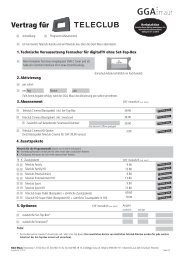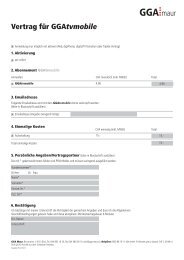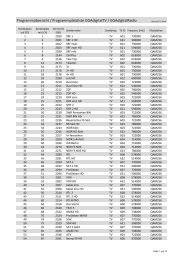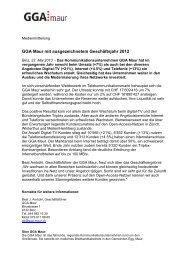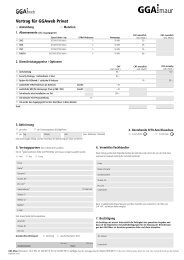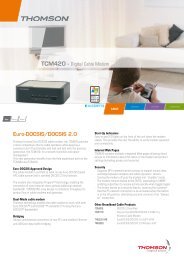Prestige 964 Cable Router Operator's Guide - bei GGA Maur
Prestige 964 Cable Router Operator's Guide - bei GGA Maur
Prestige 964 Cable Router Operator's Guide - bei GGA Maur
Create successful ePaper yourself
Turn your PDF publications into a flip-book with our unique Google optimized e-Paper software.
<strong>Prestige</strong> <strong>964</strong> <strong>Cable</strong> <strong>Router</strong><br />
FCC<br />
Firewall<br />
Flash memory<br />
FTP<br />
Gateway<br />
Hacker<br />
The FCC (Federal Communications Commission) is in charge of allocating the electromagnetic<br />
spectrum and thus the bandwidth of various communication systems.<br />
A hardware or software "wall" that restricts access in and out of a network. Firewalls are most<br />
often used to separate an internal LAN or WAN from the Internet.<br />
The nonvolatile storage that can be electrically erased and reprogrammed so that data can be<br />
stored, booted, and rewritten as necessary.<br />
File Transfer Protocol is an Internet file transfer service that operates on the Internet and over<br />
TCP/IP networks. FTP is basically a client/server protocol in which a system running the FTP<br />
server accepts commands from a system running an FTP client. The service allows users to send<br />
commands to the server for uploading and downloading files. FTP is popular on the Internet<br />
because it allows for speedy transfer of large files between two systems.<br />
A gateway is a computer system or other device that acts as a translator between two systems that<br />
do not use the same communication protocols, data formatting structures, languages, and/or<br />
architecture.<br />
Generally, a hacker is anyone who enjoys experimenting with technology including computers<br />
and networks. Not all hackers are criminals breaking into systems. Some are legitimate users and<br />
hobbyists. Nevertheless, some are dedicated criminals or vandals.<br />
HDLC<br />
Headend<br />
HFC<br />
Host<br />
HTTP<br />
IANA<br />
ICMP<br />
Integrity<br />
internet<br />
Internet<br />
Internet Worm<br />
Intranet<br />
Intruder<br />
IP<br />
IPCP (PPP)<br />
IPX<br />
HDLC (High-level Data Link Control) is a bit-oriented (the data is monitored bit by bit), link<br />
layer protocol for the transmission of data over synchronous networks.<br />
Central distribution point for a CATV system. Video signals are received here from satellites and<br />
maybe other sources, frequency converted to the appropriate channels combined with locally<br />
originated signals and rebroadcast onto the HFC plant. The headend is where the CMTS is<br />
normally located.<br />
HFC (hybrid fiber coaxial cable) is a telecommunication technology in which fiber optic cable<br />
and coaxial cable are used in different portions of a network to carry broadband content (such as<br />
video, data and voice). Typically, a local cable TV company might use fiber optic cable from the<br />
cable headend (distribution center) to serving nodes located close to business and residential<br />
users and from these nodes use coaxial cable to individual businesses and homes. An advantage<br />
of HFC is that some of the characteristics of fiber optic cable (high bandwidth and low noise and<br />
interference susceptibility) can be brought close to the user without having to replace the existing<br />
coaxial cable that is installed all the way to the home and business.<br />
Any computer on a network that is a repository for services available to other computers on the<br />
network. It is quite common to have one host machine provide several services, such as WWW<br />
and USENET.<br />
Hyper Text Transfer Protocol. The most common protocol used on the Internet. HTTP is the<br />
primary protocol used for web sites and web browsers. It is also prone to certain kinds of attacks.<br />
Internet Assigned Number Authority acts as the clearinghouse to assign and coordinate the use of<br />
numerous Internet protocol parameters such as Internet addresses, domain names, protocol<br />
numbers, and more. The IANA Web site is at http://www.isi.edu/iana.<br />
Internet Control Message Protocol is a message control and error-reporting protocol between a<br />
host server and a gateway to the Internet. ICMP uses Internet Protocol (IP) datagrams, but the<br />
messages are processed by the TCP/IP software and are not directly apparent to the application<br />
user.<br />
Proof that the data is the same as originally intended. Unauthorized software or people have not<br />
altered the original information.<br />
(Lower case i) Any time you connect 2 or more networks together, you have an internet.<br />
(Upper case I) The vast collection of inter-connected networks that all use the TCP/IP protocols<br />
and that evolved from the ARPANET of the late 60’s and early 70’s. The Internet now (July<br />
1995) connects roughly 60,000 independent networks into a vast global internet<br />
See Worm.<br />
A private network inside a company or organization that uses the same kinds of software that you<br />
would find on the public Internet, but that is only for internal use.<br />
Person or software interested in breaking computer security to access, modify, or damage data.<br />
Also see Cracker.<br />
Internet Protocol he IP (currently IP version 4, or IPv4), is the underlying protocol for routing<br />
packets on the Internet and other TCP/IP-based networks.<br />
IP Control Protocol allows changes to IP parameters such as the IP address.<br />
Internetwork Packet eXchange The native NetWare internetworking protocol is IPX<br />
(Internetwork Packet Exchange). Like IP (Internet Protocol), IPX is an internetworking protocol<br />
that provides datagram services.<br />
Glossary<br />
E



